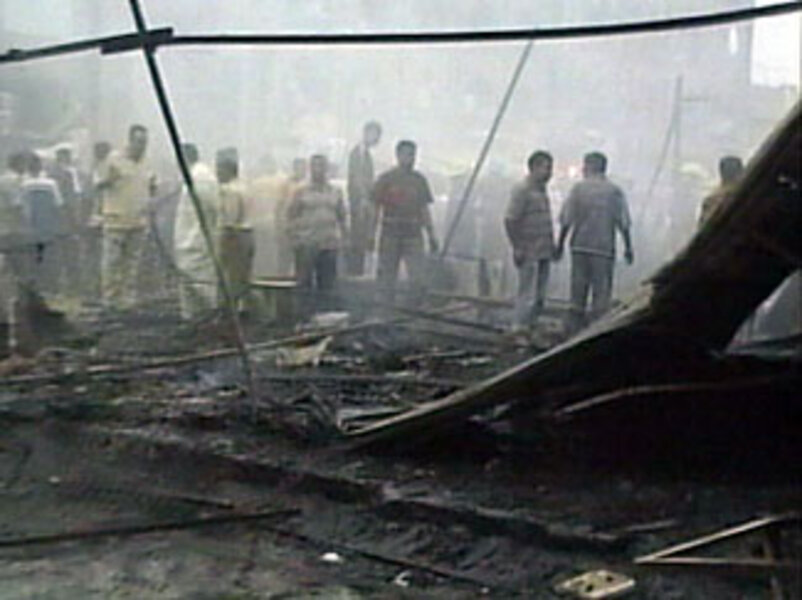U.S. says Baghdad bombing was meant to reignite sectarian violence
Loading...
| BAGHDAD
The US military has blamed a little-known Shiite cell leader for the worst bombing attack to hit the Iraqi capital since March. Tuesday evening's attack struck a marketplace in a predominantly Shiite neighborhood leaving at least 63 dead and wounding more than 70.
The truck bombing in Hurriyah shatters a relative calm in Baghdad that has seen the number of attacks against Iraqi civilians as of mid-June drop by 86 percent compared with a year ago, according to US military figures.
Based on intelligence "corroborated through multiple sources," the US said the Hurriyah attack was masterminded by Haidar Mehdi Kadhim al-Fawadi, a wanted leader in the so-called Special Groups (SGs). A military spokesman said the bombing was intended to reignite Sunni-Shiite violence in a section of the city that saw some of the worst episodes of sectarian-motivated murders, bombings, and mass evictions of Sunni Arabs from 2005 to 2007.
"His intent was to disrupt Sunni resettlement in Hurriyah in order to maintain extortion of real estate rental income to support his nefarious activities," said Lt. Col. Steve Stover, a US military spokesman in Baghdad, in an e-mail sent to reporters.
America has long charged that the SGs were rogue elements of the Mahdi Army militia of Shiite cleric Moqtada al-Sadr being trained, equipped, and sheltered by neighboring Iran and responsible for sophisticated and lethal roadside bombings using armor-piercing explosives that have killed many US soldiers.
It has rarely blamed these groups, let alone specific members, for the type of mass casualty bombings that became a trademark of Al Qaeda in Iraq (AQI). Colonel Stover said that nearly 200 to 300 pounds of "an unknown bulk explosive" were used in the attack but that "the type of vehicle and material leads us to ascertain this was not AQI."
The US military has stepped up its media and public relations campaign against SGs. It now calls them outlaws and fringe elements that have no connection to the Mahdi Army following a government negotiated truce with Mr. Sadr last month. That cease-fire ended weeks of fighting with his militia that left more than 1,000 dead in his Baghdad bastion of Sadr City.
The latest US accusations are also significant because the Mahdi Army is generally regarded by many Shiites as being the protector of the community and faith against Sunni extremists.
At the scene of the bombing Wednesday, Iraqi civil defense crews were still frantically trying to remove the dead from under the debris of concrete and twisted metal at a multilevel building in the market that bore the brunt of the explosion.
US soldiers stood nearby inspecting the devastation. A group of women veiled in black descended on the scene and began to sob and slap their faces in mourning after learning that the body of a relative may be beneath the rubble.
Most of the dead owned simple market stalls across from the building where the explosive-laden vehicle had been parked, according to witnesses.
Some of the residents interviewed had mixed views as to who may be responsible for the bombing.
Bassim Mahmoud, who lost his home and had his arm broken in the attack, said Iraqi forces stationed in the area were to blame for their "laxity and incompetence" in protecting the market. "This country is a free-for-all. People have become bad inside."
Nizar al-Sharie, owner of a calligraphy and painting studio nearby who was busy drafting the black funeral banners bearing the names of the dead, says the attack may have been aimed at the US soldiers attending a neighborhood council meeting less than 500 feet from the site of the attack but that the explosion may have gone off prematurely.
He says everyone knew that US soldiers came to this meeting every Tuesday at almost the same time.
Colonel Stover described this as "speculative."
Mr. Sharie spoke highly of the Mahdi Army and the help they had provided residents of Hurriyah in the past in securing fuel, protecting the market, and mediating disputes.
He says he has never heard of Mr. Fawadi, the militia leader accused of Tuesday's bombing.
In a strategy that has been implemented all over Baghdad and dubbed "safe neighborhoods," the US military is nearly finished building a high wall around Hurriyah. The idea is that this – combined with the US and Iraqi troop presence at outposts inside the walls – will keep militants away, while allowing the US military and the Iraqi government to provide basic services and jobs for residents and steer them away from militant influences.
This has been a central theme to the US surge in troops that helped reduce violence in Baghdad. But Tuesday's attack is a stark reminder of the fragility of the situation in Iraq's capital and the limitations of the strategy in the absence of a fundamental resolution on the issues that continue to divide Iraqis.
[Editor's note: The original article misstated the identity of an Iraqi man who appeared on a US military wanted poster.]






